Last Updated on 6 months by Francis
Welcome to our comprehensive comparison guide on IPL and Red Light Therapy. As the beauty industry continues to evolve, it’s imperative to know the difference between these two light-based treatments. IPL therapy focuses on specific skin concerns like hyperpigmentation, while Red Light Therapy is known for promoting cellular regeneration and overall skin health. Choosing the right treatment can be confusing, but we’re here to help you make an informed decision.
Contents
Key Takeaways
- IPL and Red Light Therapy are light-based treatments for skin concerns and rejuvenation.
- IPL targets specific skin issues, while Red Light Therapy promotes overall skin health.
- The best treatment depends on an individual’s needs, preferences, and treatment goals.
- It is important to consult with a qualified professional before undergoing either treatment.
- Ongoing research continues to explore the potential uses and improvements in treatment efficacy and safety.
Understanding IPL Treatment for Skin
In recent years, IPL treatment has become increasingly popular as a non-invasive method for treating various skin concerns. This treatment uses high-intensity light to target specific areas of the skin, such as sun damage, age spots, and hyperpigmentation. Unlike laser therapy, which uses a single concentrated beam of light, IPL uses a broad spectrum of light to address multiple skin concerns simultaneously.
The treatment works by delivering intense pulses of light to the deeper layers of the skin, where it is absorbed by melanin and other pigments in the skin. This process stimulates the production of collagen, which promotes skin rejuvenation and can help to reduce the appearance of fine lines and wrinkles.
How Does IPL Treatment Work?
During the treatment, a handheld device is applied to the skin, emitting pulses of light. The light energy penetrates the skin and targets the underlying tissues, causing minor damage to the pigmented areas. The body’s natural response to this damage is to initiate the healing process, which stimulates the production of collagen and new skin cells.
As a result, IPL treatment can effectively reduce the appearance of skin blemishes, fine lines, and wrinkles, leaving the skin looking smoother and more youthful.
| Pros | Cons |
|---|---|
| Non-invasive | May cause temporary redness or swelling |
| Can be used on various skin types | Not effective on deep wrinkles or scarring |
| Minimal downtime | May require multiple sessions for optimal results |
It is important to note that IPL treatment may not be suitable for everyone and may not provide optimal results for all skin concerns. A consultation with a qualified professional can help determine if you are a suitable candidate for IPL treatment and what to expect from the procedure.
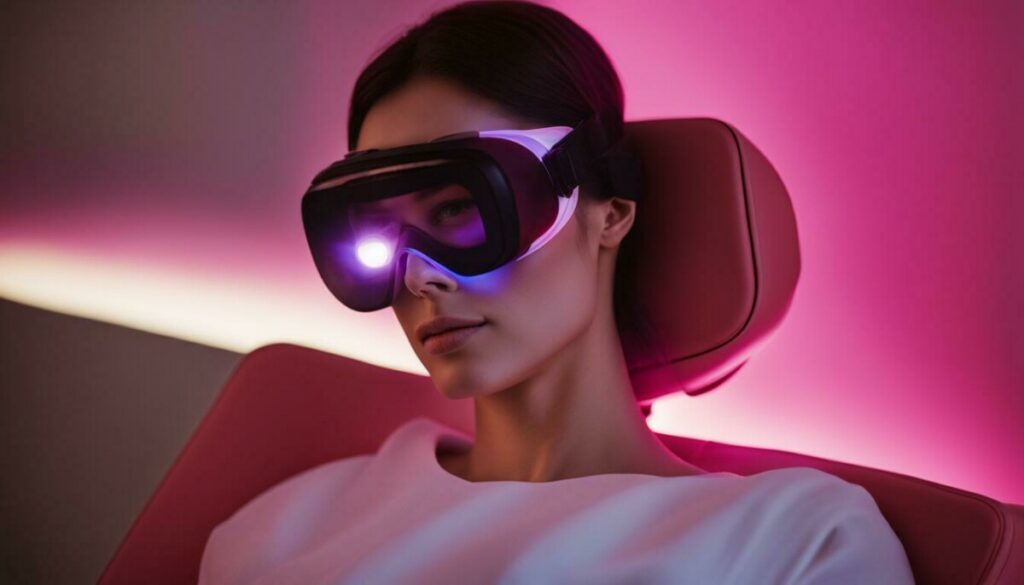
“IPL treatment has been life-changing for me. It’s helped to reduce my age spots and dark patches, leaving my skin looking and feeling smoother than ever before.” – Sarah, 42
Exploring the Benefits of Red Light Therapy
Red Light Therapy, also known as Low-Level Laser Therapy (LLLT), is a non-invasive treatment that has gained popularity in recent years. It utilizes specific wavelengths of red or near-infrared light to promote cellular regeneration and healing in the body.
The benefits of Red Light Therapy are numerous and diverse. Let’s take a look at some of the key ways this treatment can positively impact your health:
Enhances Skin Health
Red Light Therapy can do wonders for your skin. It stimulates collagen production, improves skin elasticity, and enhances overall skin tone and texture. By increasing blood flow to the skin, it can even help reduce the appearance of fine lines and wrinkles.

Reduces Inflammation
Inflammation is a common cause of pain and discomfort in the body. Red Light Therapy has been found to reduce inflammation by promoting cellular regeneration and improving blood circulation.
Relieves Pain
Red Light Therapy has also been found effective in relieving pain. It can help reduce muscle soreness, joint pain, and even chronic conditions like arthritis.
Promotes Wound Healing
Whether you have a minor cut or a more serious injury, Red Light Therapy can help speed up the healing process. It promotes cellular growth and reduces inflammation, which can enhance collagen synthesis, speed up tissue repair, and minimize scarring.
Improves Mood
Red Light Therapy has been found to have mood-boosting effects, making it a popular treatment for seasonal affective disorder (SAD). By improving blood flow and reducing inflammation, it can enhance overall well-being and reduce feelings of depression and anxiety.
In conclusion, Red Light Therapy has numerous benefits for both physical and mental health. By promoting cellular regeneration, reducing inflammation, and enhancing skin health, it can have a positive impact on your overall well-being. Whether you’re looking to reduce pain, improve your skin, or enhance your mood, Red Light Therapy is worth considering.
Effectiveness of IPL vs Laser Therapy
When it comes to light-based skin treatments, IPL (Intense Pulsed Light) and laser therapy are two popular options. Both treatments use light to target various skin concerns, but the type and intensity of light used differs between the two.
IPL is a broader spectrum of light that can target multiple skin concerns, such as sun damage, age spots, and hyperpigmentation. IPL delivers a pulse of light that penetrates the skin and is absorbed by specific skin pigments, damaging the targeted tissue and stimulating the body’s natural healing response.
Laser therapy, on the other hand, uses a focused beam of light to target specific issues, such as hair removal or skin resurfacing. The light energy from the laser is absorbed by the target area, heating and damaging the tissue to promote healing and regeneration.
While both IPL and laser therapy can be effective for treating various skin concerns, each treatment has its unique benefits and limitations. IPL is generally more versatile and can treat a wider range of skin concerns, while laser therapy is more targeted and can achieve more precise results.
Choosing between IPL and Laser Therapy
When deciding between IPL and laser therapy, it’s important to consider your individual needs and treatment goals. If you have multiple skin concerns or want to improve overall skin tone and texture, IPL may be the better option. If you have specific issues that require more targeted treatment, such as hair removal or scar reduction, laser therapy may be more suitable.
It’s also important to note that both IPL and laser therapy require multiple treatment sessions to achieve optimal results. The number of sessions needed can vary depending on the specific skin concern being treated and individual factors such as skin type and sensitivity.
Ultimately, the choice between IPL and laser therapy comes down to personal preference and individual needs. Consult with a qualified professional to determine which treatment is right for you.
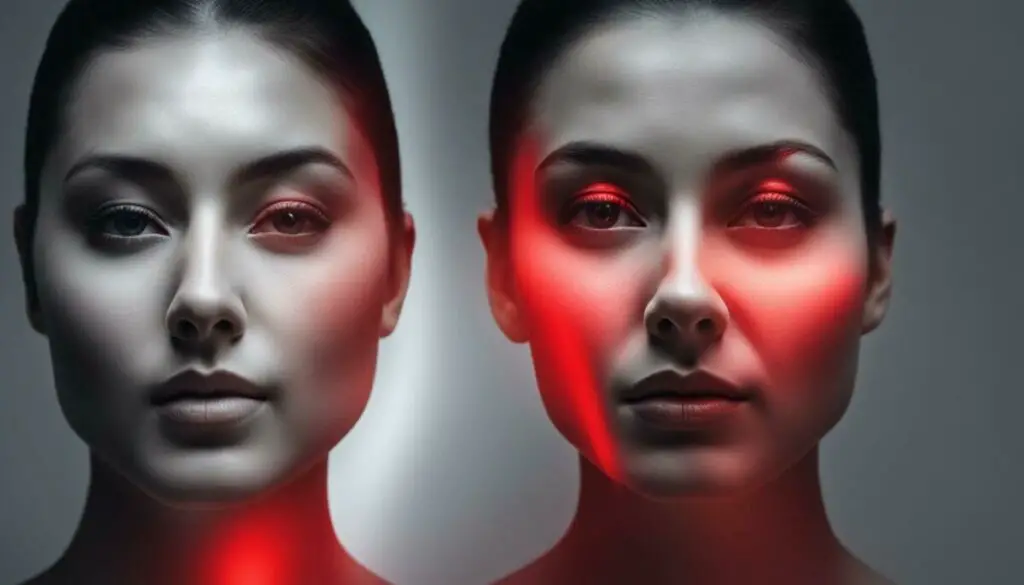
Red Light Therapy for Acne Treatment
If you suffer from acne, you know how frustrating it can be. Acne can affect your confidence and self-esteem. Fortunately, Red Light Therapy has shown promising results in treating acne by reducing inflammation, killing bacteria, and promoting healing.
Red Light Therapy penetrates deep into the skin, targeting the sebaceous glands and reducing oil production, which can contribute to acne breakouts. It also stimulates collagen production, which can help reduce scarring and improve skin texture.
According to a study published in the Journal of Clinical and Aesthetic Dermatology, Red Light Therapy significantly reduced the number of acne lesions in participants after just four weeks of treatment.

One of the advantages of Red Light Therapy for acne is that it has no known side effects, making it a safe and effective treatment option for people of all ages. It is a non-invasive and painless procedure, and you can use it at home or in a professional setting.
If you are looking for a natural and effective way to combat acne, Red Light Therapy may be the solution you’ve been searching for.
IPL Hair Removal vs Red Light Therapy
When it comes to hair removal, both IPL and Red Light Therapy are commonly used methods. However, they work in different ways and have unique benefits. In this section, we will explore the differences between IPL hair removal and Red Light Therapy and help you determine which one is the best choice for you.
What is IPL Hair Removal?
IPL hair removal is a popular method for long-term hair reduction. It works by emitting intense light pulses into the skin, targeting the pigment in the hair follicles and impairing their ability to regrow. IPL can be used on various body areas, including the legs, arms, face, and bikini line. It is a fast and effective method, with visible results after just a few sessions.
What is Red Light Therapy?
Red Light Therapy, on the other hand, is not typically used for hair removal. Instead, it focuses on promoting skin health and rejuvenation. It utilizes specific wavelengths of red or near-infrared light to stimulate cellular regeneration and healing. It has been found to have various benefits, including reducing inflammation, improving skin health, and relieving pain.
How Do They Compare?
| IPL Hair Removal | Red Light Therapy | |
|---|---|---|
| Method | Emits intense light pulses into the skin to target hair follicles | Utilizes specific wavelengths of red or near-infrared light to stimulate cellular regeneration and healing |
| Target Area | Can be used on various body areas, including legs, arms, face, and bikini line | Typically focused on the face and neck, but can also be used on other body areas to promote skin health and healing |
| Results | Visible results after a few sessions | Gradual improvement with continued use |
While IPL hair removal is focused on removing hair, Red Light Therapy is primarily used for skin rejuvenation. However, Red Light Therapy has shown promising results in promoting hair growth when used in combination with other treatments, such as minoxidil.
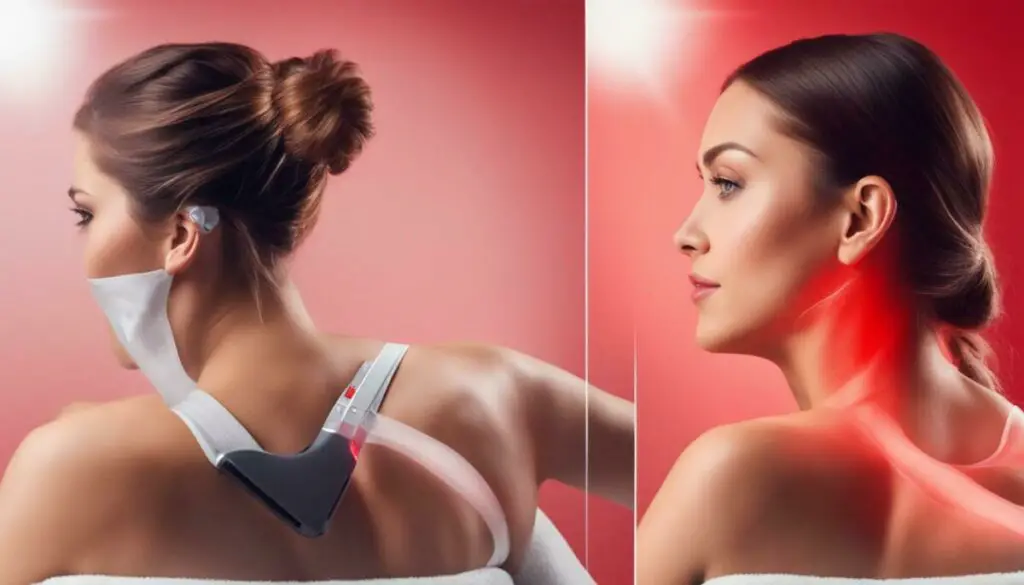
When deciding between IPL hair removal and Red Light Therapy, consider your specific needs and goals. If you are looking for a fast and effective method for hair removal on various body areas, IPL may be the best choice for you. If you are looking to improve overall skin health and promote cellular regeneration, Red Light Therapy may be the better option. It is recommended to consult with a qualified professional to determine the most suitable treatment for you.
Red Light Therapy for Anti-Aging
As we age, our skin loses elasticity, and fine lines and wrinkles begin to appear. Fortunately, Red Light Therapy offers a promising solution for those looking to combat the signs of aging.
Red Light Therapy works by penetrating the skin and stimulating collagen production, which is essential for maintaining skin elasticity and suppleness. It also improves blood circulation, allowing the skin to absorb more nutrients and oxygen, resulting in a more youthful and radiant appearance.
Studies have shown that Red Light Therapy can significantly reduce the appearance of wrinkles and fine lines, as well as improve overall skin texture and tone. Additionally, it can improve skin hydration and reduce inflammation, making it an excellent option for those with dry or sensitive skin.

One of the significant advantages of Red Light Therapy is that it is a non-invasive and painless procedure. Unlike other anti-aging treatments, such as chemical peels or laser resurfacing, there is no downtime or recovery period required.
Red Light Therapy can be applied to the face, neck, and other areas of the body that show signs of aging. It is suitable for all skin types and can be used in combination with other anti-aging treatments for optimal results.
If you are looking for a safe and effective way to reduce the signs of aging, Red Light Therapy may be the solution for you. Consult with a qualified professional to determine the best course of treatment for your specific needs.
IPL vs Red Light Therapy for Skin Rejuvenation
Both IPL and Red Light Therapy have benefits for skin rejuvenation, but the mechanisms of action differ. IPL targets specific skin concerns by delivering intense pulses of light, while Red Light Therapy promotes overall skin health and rejuvenation by stimulating cellular regeneration.
When it comes to skin rejuvenation, IPL may be a better option for those with specific skin issues, such as sun damage or hyperpigmentation. Red Light Therapy, on the other hand, may be more suitable for those looking to improve their overall skin health and appearance.
It is important to consider individual needs and preferences when deciding between the two therapies. Consultation with a qualified professional is recommended to determine the most appropriate treatment.
| IPL | Red Light Therapy |
|---|---|
| Targets specific skin concerns such as sun damage, age spots, and hyperpigmentation | Promotes overall skin health and rejuvenation by stimulating cellular regeneration |
| Delivers intense pulses of light to the skin | Utilizes specific wavelengths of red or near-infrared light |
| May require multiple sessions for optimal results | May see results with regular use of device, available for home use |

Red Light Therapy for Pain Relief
Red Light Therapy has been found to provide effective relief for various types of pain, including joint pain, muscle strains, and arthritis. This non-invasive treatment uses specific wavelengths of red light to penetrate deep into the skin and tissues, reducing inflammation and promoting tissue regeneration.
Research has shown that Red Light Therapy can stimulate the production of ATP (Adenosine Triphosphate), a molecule that provides energy to cells. This helps in the repair of damaged tissues and reduces pain sensation by blocking pain-transmitting neurons.
In addition to its pain-relieving properties, Red Light Therapy has also been found to enhance physical performance and muscle endurance. It can improve blood circulation and oxygenation, reducing muscle fatigue and promoting faster recovery after exercise or injury.

While Red Light Therapy is generally safe and well-tolerated, it is essential to consult with a qualified professional before undergoing treatment. Individuals with light-sensitive conditions or those taking medications that increase sensitivity to light should exercise caution when considering this treatment.
Red Light Therapy provides a natural and non-invasive alternative to traditional pain management methods, offering relief without the side effects of medications or invasive procedures.
The Healing Potential of Red Light Therapy for Wound Healing
Red Light Therapy has been found effective in accelerating wound healing by promoting cellular growth and reducing inflammation. This therapy stimulates the production of ATP, a molecule critical for cellular energy, which helps damaged cells to repair and regenerate faster.
Studies have shown that red light therapy improves wound healing in various conditions, such as diabetic ulcers, pressure sores, and burns. In one study, patients with venous leg ulcers who received red light therapy showed a significant improvement in wound size reduction compared to those who received standard care.
Red light therapy also has anti-inflammatory properties that can help reduce swelling and pain associated with wounds. In a study conducted on rats, red light therapy was found to decrease inflammation and accelerate healing in skin wounds.

Red Light Therapy is a non-invasive and painless treatment option for wound healing. It is a safe and effective therapy that can be used alongside other treatments to enhance the healing process.
If you are considering Red Light Therapy for wound healing, it is essential to consult with a qualified professional to determine the appropriate treatment plan for your specific condition.
Exploring IPL vs Red Light Therapy for Skin Rejuvenation
Both IPL and Red Light Therapy have been found effective in promoting skin rejuvenation, but they employ different mechanisms of action.
IPL targets specific skin concerns, such as sun damage, hyperpigmentation, and age spots, by delivering intense light pulses to the deeper layers of the skin. The light energy is absorbed by the pigmented areas, causing them to break down and fade over time. IPL also stimulates collagen production, promoting skin rejuvenation and improving overall texture and tone.
Red Light Therapy, on the other hand, focuses on cellular regeneration and overall skin health. It uses specific wavelengths of red or near-infrared light to penetrate the skin, promoting the production of ATP and enhancing cellular metabolism. This results in improved elasticity, firmness, and a reduction in the appearance of fine lines and wrinkles.
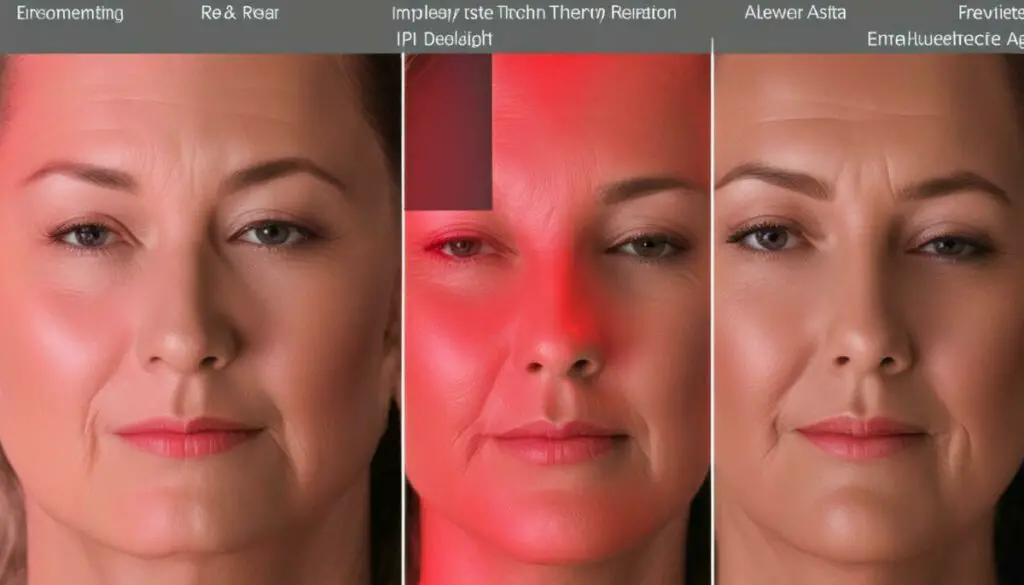
While IPL and Red Light Therapy share the goal of skin rejuvenation, the choice between the two depends on the individual’s specific skin concerns and goals. IPL may be more suitable for those with specific pigmentation issues, while Red Light Therapy may be better for those seeking overall skin health and anti-aging benefits.
It is important to consult with a qualified professional before undergoing either treatment to determine the most appropriate option for you.
Comparing IPL and Red Light Therapy Safety Profile
Both IPL and Red Light Therapy are non-invasive procedures that are generally safe and well-tolerated. However, as with any medical treatment, there are potential risks and side effects that should be considered before undergoing either therapy. It is crucial to consult with a qualified professional to determine whether IPL or Red Light Therapy is right for you and to discuss any potential concerns you may have.
Risks and Side Effects of IPL
IPL therapy is generally considered safe, but some potential risks and side effects include:
| Potential Risks | Side Effects |
|---|---|
| – Burns and blisters | – Redness and swelling |
| – Hyperpigmentation | – Itching and stinging |
| – Hypopigmentation | – Bruising |
These side effects are typically mild and subside within a few days to a week following treatment.
Risks and Side Effects of Red Light Therapy
Red Light Therapy is generally safe and has very few side effects. However, some potential risks and side effects include:
| Potential Risks | Side Effects |
|---|---|
| – Eye damage | – Mild headaches |
| – Skin irritation | – Nausea |
| – Interference with medication | – Dizziness |
It is important to note that the risks and side effects of Red Light Therapy are rare and usually mild. If you experience any unusual symptoms after undergoing Red Light Therapy, you should contact a healthcare professional immediately.
Important Note: Individuals who are pregnant, have epilepsy, or are taking medication that causes light sensitivity should avoid IPL and Red Light Therapy to prevent potential complications.
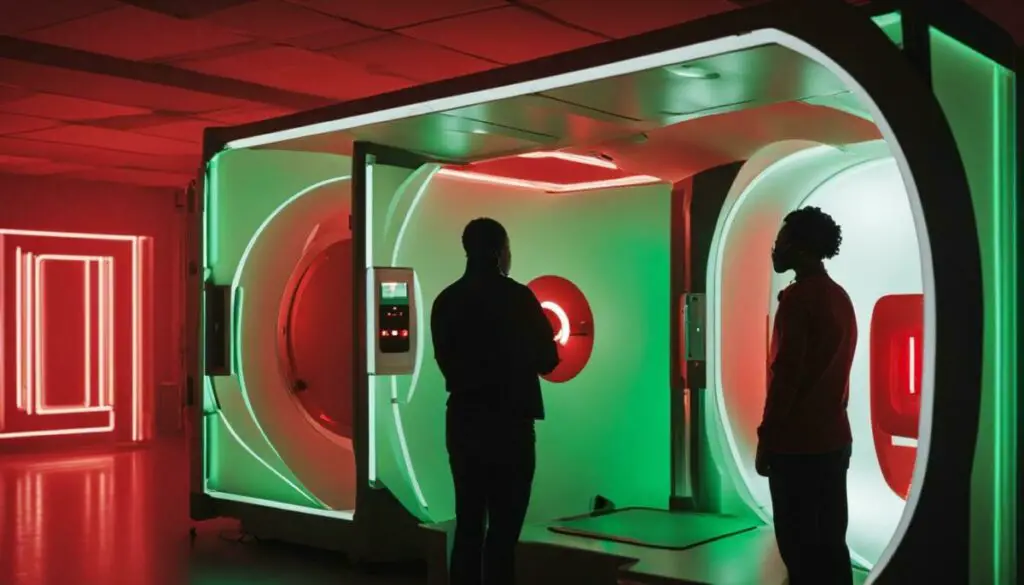
Understanding the Cost and Maintenance of IPL vs Red Light Therapy
Before deciding on the most suitable treatment, it is important to consider the cost and maintenance requirements of IPL and Red Light Therapy.
IPL treatments are typically more expensive than Red Light Therapy. The cost of an IPL treatment varies depending on the area being treated and the number of sessions required. On average, a single session can cost anywhere from $400 to $600, with multiple sessions recommended for optimal results. This can make IPL more expensive than Red Light Therapy in the long run.
Red Light Therapy devices, on the other hand, can be more cost-effective in the long term. While the upfront cost may be higher than a single IPL session, devices can be used multiple times in the comfort of your own home. This eliminates the need for ongoing appointments and can save both time and money in the long run. Red Light Therapy devices can range in price from $100 to $500, depending on the quality and features of the device.
The maintenance requirements for IPL and Red Light Therapy can also differ. IPL requires maintenance appointments every 6 to 12 months to maintain results, while Red Light Therapy devices require replacement bulbs or batteries as needed. It is important to factor in the ongoing maintenance costs when deciding which treatment is right for you.
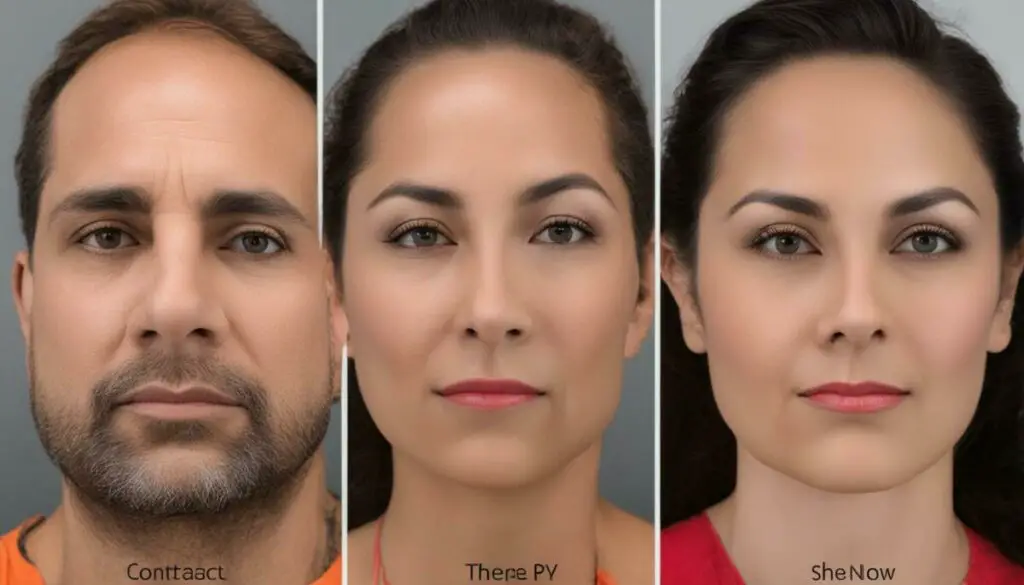
Note: The cost and maintenance requirements for both IPL and Red Light Therapy can vary depending on the individual and the area being treated. It is recommended to consult with a qualified professional to determine the most suitable and cost-effective treatment option for your individual needs.
Considering the Limitations of IPL and Red Light Therapy
While IPL and Red Light Therapy offer numerous benefits for various skin concerns, it is important to understand their limitations.
IPL is not suitable for darker skin tones as it may cause hyperpigmentation. It is also not effective for hair removal on lighter hair colors or for treating deep scars or wrinkles.
Red Light Therapy may not be suitable for pregnant women, individuals with light sensitivity or those taking medication that causes photosensitivity. It is also not effective for removing tattoos or hair.
Both IPL and Red Light Therapy may have potential side effects such as skin irritation, redness, and blistering. It is crucial to consult with a qualified professional before undergoing either treatment.
It is also essential to note that while these treatments may provide significant improvements, they are not permanent and require maintenance sessions to upkeep the results.
Understanding the limitations and potential side effects of IPL and Red Light Therapy is crucial for making an informed decision about which treatment may be best for you.
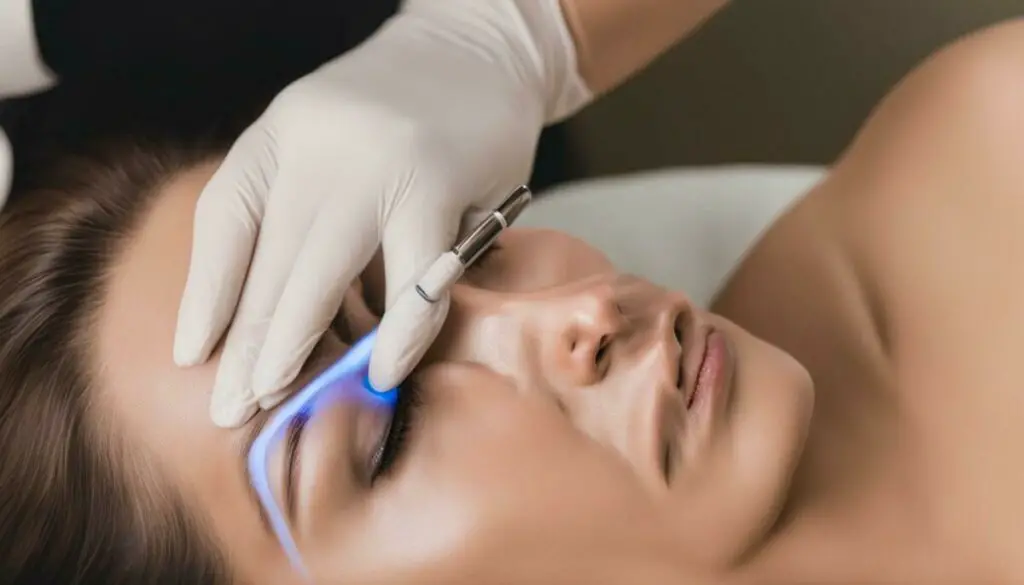
The Future of IPL and Red Light Therapy in Skin Care
The use of IPL and Red Light Therapy in skin care has gained significant popularity in recent years, and ongoing research and development indicate a bright future for these treatments.
Advancements in IPL technology can improve treatment efficacy and safety. For instance, some new devices feature cooling mechanisms that help prevent burns and discomfort during the procedure. Additionally, the development of handheld IPL devices has made the treatment more accessible to the wider public, reducing the need for clinic visits and making it more cost-effective long-term.
Red Light Therapy is also undergoing constant development, with researchers exploring new applications beyond the treatment of skin conditions and pain relief. Some studies suggest that Red Light Therapy can boost athletic performance, reduce the risk of dementia, and even improve mental health.
The future of IPL and Red Light Therapy in skin care is also likely to involve the integration of artificial intelligence and automation technology. For example, some clinics have already implemented AI-powered skin analysis technologies that can provide tailored and precise treatment recommendations based on individual skin type and needs.
Overall, the future of IPL and Red Light Therapy in skin care looks promising, with new breakthroughs and advancements continually emerging.

Conclusion
After exploring the differences between IPL and Red Light Therapy, it is clear that both treatments offer unique benefits for various skin concerns. IPL is effective in targeting specific skin issues such as sun damage, age spots, and hyperpigmentation, while Red Light Therapy promotes overall skin health and rejuvenation, providing benefits such as reducing inflammation, enhancing skin health, and relieving pain.
When it comes to hair removal, IPL is the preferred option, while Red Light Therapy is commonly used for acne treatment, anti-aging, wound healing, and pain relief.
It is important to note that both treatments have potential risks and side effects, so it is crucial to consult with a qualified professional before undergoing any treatment.
Ultimately, the best choice between IPL and Red Light Therapy depends on individual needs, preferences, and treatment goals. It is recommended to consult with a qualified professional to determine the most suitable option for you.
The Future of IPL and Red Light Therapy in Skincare
The field of skincare and aesthetics is constantly evolving, and IPL and Red Light Therapy continue to gain popularity. Ongoing research is exploring new applications of these treatments and improvements in efficacy and safety. It’s exciting to see what the future holds for IPL and Red Light Therapy as they continue to revolutionize the field of skincare.
Thank you for reading this comprehensive comparison guide on IPL vs Red Light Therapy, and we hope it has helped you make an informed decision about which treatment is right for you.
FAQ
What is the difference between IPL and Red Light Therapy?
IPL (Intense Pulsed Light) therapy uses high-intensity light to target specific skin concerns, while Red Light Therapy utilizes specific wavelengths of red or near-infrared light for cellular regeneration and healing.
How does IPL treatment work for the skin?
IPL treatment delivers intense pulses of light to the deeper layers of the skin, stimulating collagen production and promoting skin rejuvenation.
What are the benefits of Red Light Therapy?
Red Light Therapy has various benefits, including reducing inflammation, enhancing skin health, and relieving pain.
How effective is IPL compared to laser therapy?
IPL targets multiple skin concerns with a broader spectrum of light, while laser therapy uses a focused beam of light for specific issues like hair removal or skin resurfacing.
Can Red Light Therapy help with acne treatment?
Red Light Therapy has shown promising results in reducing acne by reducing inflammation, killing bacteria, and promoting healing.
What’s the difference between IPL hair removal and Red Light Therapy?
IPL hair removal focuses on long-term hair reduction, while Red Light Therapy is more focused on skin health and rejuvenation.
Can Red Light Therapy help with anti-aging?
Red Light Therapy stimulates collagen production, improves skin elasticity, and reduces fine lines and wrinkles for a more youthful appearance.
Which is better for skin rejuvenation, IPL or Red Light Therapy?
IPL targets specific skin concerns, while Red Light Therapy stimulates cellular regeneration and overall skin health. The choice depends on individual goals.
Does Red Light Therapy provide pain relief?
Red Light Therapy has been found effective in relieving pain by reducing inflammation, stimulating tissue regeneration, and improving blood circulation.
Can Red Light Therapy help with wound healing?
Red Light Therapy accelerates wound healing by promoting cellular growth, reducing inflammation, and enhancing tissue repair.
What are the safety profiles of IPL and Red Light Therapy?
Both IPL and Red Light Therapy are generally safe, but it is important to consult with a qualified professional before undergoing either treatment.
How much do IPL and Red Light Therapy cost?
IPL treatments are typically more expensive and may require multiple sessions, while Red Light Therapy offers a more cost-effective long-term solution, with devices available for home use.
Are there any limitations to IPL and Red Light Therapy?
IPL and Red Light Therapy may not be suitable for everyone or every skin condition, considering factors such as skin type, medical history, and individual requirements.
What does the future hold for IPL and Red Light Therapy in skincare?
Ongoing research is exploring new applications and improvements in efficacy and safety for IPL and Red Light Therapy in the field of skincare and aesthetics.
Which is better, IPL or Red Light Therapy?
The choice between IPL and Red Light Therapy depends on individual needs, preferences, and treatment goals. It is recommended to consult with a qualified professional to determine the most suitable option.


.jpg)
.jpg)
.jpg)



